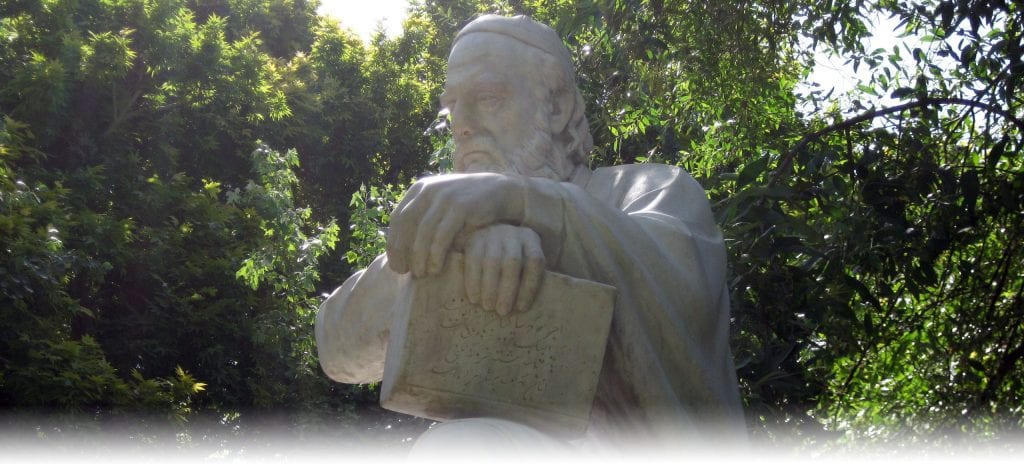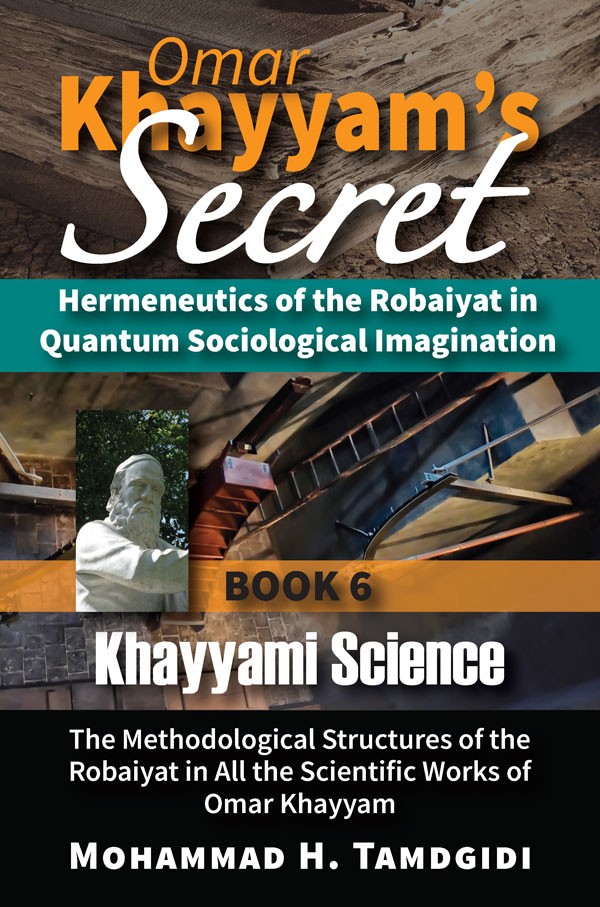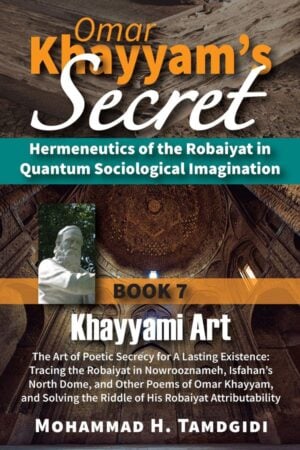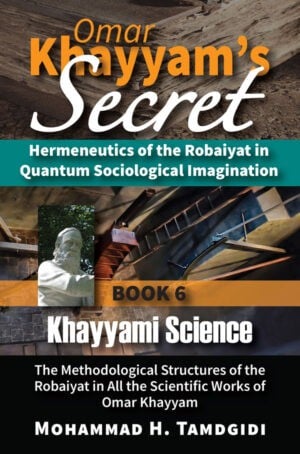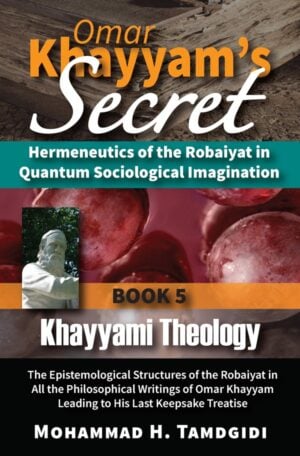Book Section: CHAPTER IV—Omar Khayyam’s Treatise on the Proofs of Problems in Algebra and Equations: The Arabic Text, the Persian Translation by Gholamhossein Mosaheb, and Its New English Translation, Followed by Textual Analysis — by Mohammad H. Tamdgidi
$20.00
This essay titled “Omar Khayyam’s Treatise on the Proofs of Problems in Algebra and Equations: The Arabic Text, the Persian Translation by Gholamhossein Mosaheb, and Its New English Translation, Followed by Textual Analysis” is the fourth chapter of the book Khayyami Science: The Methodological Structures of the Robaiyat in All the Scientific Works of Omar Khayyam, which is the sixth volume of the twelve-book series Omar Khayyam’s Secret: Hermeneutics of the Robaiyat in Quantum Sociological Imagination, authored by Mohammad H. Tamdgidi.
Description
Abstract
This essay titled “Omar Khayyam’s Treatise on the Proofs of Problems in Algebra and Equations: The Arabic Text, the Persian Translation by Gholamhossein Mosaheb, and Its New English Translation, Followed by Textual Analysis” is the fourth chapter of the book Khayyami Science: The Methodological Structures of the Robaiyat in All the Scientific Works of Omar Khayyam, which is the sixth volume of the twelve-book series Omar Khayyam’s Secret: Hermeneutics of the Robaiyat in Quantum Sociological Imagination, authored by Mohammad H. Tamdgidi.
In this chapter, Tamdgidi offers a hermeneutic analysis of Omar Khayyam’s “Treatise on the Proofs of the Problems of Algebra and Equations” (رسالة فى البراهين على مسائل الجبر و المقابلة). For the purpose, following some introductory comments, the Arabic text of the manuscript along with its Persian translation published in 1960 by the late Gholamhossein Mosaheb (1910-1979), is presented, followed by Tamdgidi’s new English translation of the text based on Mosaheb’s Persian translation. He then presents his analysis of the text.
Mosaheb, a prominent University of Cambridge educated professor of mathematics and logic in Iran was fluent in Arabic, English, and French with familiarity with Russian. He consulted Franz Woepcke’s French translation of the treatise (accompanied by its Arabic text) in L’Algèbre D’Omar Alkhayyami (1851) for his efforts, and offered a careful rendition of the treatise in Arabic and its Persian translation which has since been used as a source and reference by scholars in Iran and abroad.
Tamdgidi’s analysis of Khayyam’s treatise in this chapter is not intended to be technically evaluative but hermeneutic, trying to understand its content in terms of the meaning it had for Khayyam in the context of his worldview as a whole.
Applying Khayyam’s own three-steps whether (it exists), what (exists), and why (it exists) exploratory framework as introduced in his theological treatise “Resalat fi al-Kown wa al-Taklif” (“Treatise on the Created World and Worship Duty”), Tamdgidi’s aim is to address questions surrounding the existence of the treatise itself, the meaning of what Khayyam advanced in his treatise, and why he wrote it, in the broader context of his scientific, philosophical, and theological works studied in this series so far and in anticipation of its forthcoming studies of Khayyam’s literary and poetic writings.
Hermeneutic analysis pays close attention not only to what is expressed in a text but also to what is not, yet is implied in the text, in the context of the author’s broader writings. There is also much more shared in Khayyam’s treatise in algebra than just technical material, and for reasons that invite a deeper hermeneutic understanding, Khayyam offers in the text in his synoptic ways important autobiographical, sociological, and spiritual material that are interpretively significant for understanding his works and life.
Regarding matters of existence of this treatise, Tamdgidi addresses three issues. One has to do with the important finding reported (Rashed and Vahabzadeh 1999, 2000) about the identity of the mysterious Abu Taher to whom Khayyam dedicated his treatise in algebra so sincerely; regarding this issue, Tamdgidi combs through several older and recent studies to offer a better sense of Abu Taher’s identity.
The second issue regarding matters of existence of the treatise has to do with exploring whether the new information about Abu Taher and what Khayyam reveals autobiographically in the treatise about his life and times can help us narrow down roughly when his treatise was written; regarding this issue, Tamdgidi concludes that the year 469 LH (AD 1076-77) may be regarded as a plausible date of writing of the treatise.
The third issue regarding matters of existence of the treatise has to do with the puzzling omissions made—in the published editions by Roshdi Rashed and Bijan Vahabzadeh (2000 in English, following the same in French/Arabic, 1999) of Khayyam’s treatise in algebra and its translation(s)—of most (though not all) of the prayer statements and even the identifying “Neyshabouri” attribution of Khayyam’s name for the treatise as commonly found in extant manuscripts of the treatise.
Also, the editors’ rendering of his name in English or French as “al-Khayyam” (with a notable exception of their English edition title rendered as “Omar Khayyam”) is questioned, one that appears to be related to Rashed’s doubts, as expressed in his introduction, about the scientist “al-Khayyam” being the same person as the poet “Khayyam.”
There is nothing wrong at all with rendering Khayyam’s name as “al-Khayyam”; it is what it signifies in the editions published in terms of a “two Khayyams” thesis that Tamdgidi raises as an issue to be discussed.
Beside questioning the way in which Khayyam’s name has been handled as described above, giving the impression to readers of an effort being made in cultural appropriation for Arabs of Khayyam’s legacy as an Iranian scientist (for which the doubting of his having been the author of the Robaiyat seems to serve a purpose), Tamdgidi argues that the prayer statements accompanying Khayyam’s treatise in algebra, as found also in his other treatises, must be treated as substantively integral to his scientific practice and method. Deleting them, therefore, is not only editorially improper in general when sharing old texts but also distortive of the integrity of Khayyam’s worldview. F
or the same reason, Khayyam’s autobiographical and social reflections in the introduction of his treatise should not be treated as marginal and extrinsic to his scientific method, but integral to it. The folds of spiritual, social and personal reflections in Khayyam’s narrative were intended to convey to his readers that he did not believe in a pure science divorced from social, moral, and spiritual values, but that his science was deeply embedded in his philosophical and theological views according to which the search for the true, the just, and the good, cannot be separated from one another.
Regarding the subject matter of the treatise, at the beginning of his treatise Khayyam defines the aim of algebra and equations to be the determination of unknown magnitudes by way of known magnitudes on the basis of the relations they have with one another.
He defines its subject matter as including both absolute numbers and magnitudes that are continuous quantities such as cubes, squares, and lines (also called sides or roots). The twenty-five algebraic equations Khayyam classifies in his treatise are those including one unknown magnitude as represented by the ‘thing’ (or ‘x’ in our present day language).
Khayyam applies his geometric imagination to represent the magnitudes and their relations in the algebraic equations. For him, x represents a line whose length is x, x squared (x2) represents a square surface whose side is a line of length x, and x cubed (x3), represents a cube solid any of whose twelve side lines is a line of length x-, or any of whose six square sides represent a square x2.
Khayyam also devoted a section of his treatise to defining and introducing, at times by numerical examples, the ‘parts’ (or inverse) variations of the equations that are also comprised of twenty-five variations in a classification that parallels his regular equations classification scheme. Combinations of regular and inverse equations are regarded as possible but to the extent that the third degree limit to the unknown in the equation is maintained.
This is because Khayyam was not interested in algebraic equations of degrees higher than three, since his geometric conception of what the algebraic terms represent in terms of the three dimensions made higher degrees representing (for him non-existing) higher dimensions meaningless.
He also did not use negative coefficients in his classification scheme, since at the time, negative numbers and algebraic results were not deemed practically meaningful; this explains why his classification was comprised of the twenty-five classes rather than all of them being, as expressed today, variations of the universal equation ax+bx2+cx3+d=0 where the coefficients can be positive or negative, or zero.
It is important to note that Khayyam did not claim having invented the geometric method of solving algebraic equation, a method whose practice was inherited from the Greek tradition. Rather, his contribution was the innovative way he went about imagining and applying his geometric method to solving algebraic equations, especially of the third degree by way of conic sections.
To make his innovative geometric method possible, he used a metaphorical framework such that a unit length, a unit square, and a unit cube is used to measure the unknown magnitudes of lines, squares, and cubes in an algebraic equation respectively. Again, using unit measures of lines, surfaces, and solids per se was not what is innovative here; what was innovative was how he went about defining known or unknown lines, surfaces, or solids by them and how he used the results in his solving effort.
Aside from imagining x as representing a line whose length is x number (in magnitude) of length units, x2 represents a rectangle with a side of unit length and an adjacent side whose length is x2 (in magnitude) number of length units.
Likewise, x3 represents a cuboid with a base of unit square and a height whose length is x3 number (in magnitude) of length units. This allowed the magnitudes of surfaces and solids to be expressible in line magnitudes, or vice versa, and for three-dimensional objects to be implicitly represented in his two dimensional figures.
To illustrate Khayyam’s innovative geometric method, Tamdgidi uses the example of one of the equations in Khayyam’s classification (E19) involving ‘a cube and squares and sides equal number’ (x3 + cx2 + bx = a), one that includes all the degree terms in the equation. Although Khayyam’s solving that particular equation did not require using a hyperbolic conic section, needing only a circle and a parabola for the purpose, it is still sufficiently illustrative for understanding his innovative method.
In Khayyam’s geometric method, line, square, and cubes are not treated as separate objects, as if one stands apart from another. The very same line can represent at once a line, a side of a square, and the side or base of a cube. Even a line’s magnitude can represent, in magnitude value, the surface of a rectangle or the volume of a cuboid.
This is how we should even be looking at a cube of six square surfaces, each having their line sides; in other words, in the cube, the side of one square surface is at once a line, the side of another square surface, and the side of a cube to which those surfaces belong—it represents at once a line, a square, and a cube. This innovatively served well Khayyam’s geometric method of finding unknowns by way of knowns.
That is because, even if a line is unknown as a line, it can be found by way of a known square or a known cube of which it is a side, or, more significantly, by way of the properties of known conic sections, be they circles, parabolas, and/or hyperbolas. Therefore, Khayyam’s geometric method is dialectical since it recognizes the sameness, the superposition, and the identity of opposites in the terms of his analysis.
In the algebraic equation examined (x3 + cx2 + bx = a), for example, Khayyam begins by drawing first a line EB as just a line in his two-dimensional figure, but the line for him is then also defined as a square root of ‘b’, being also the side of a square with a surface representing ‘b’ as the coefficient of x in the equation.
But he also then continues to use the same line and the square it represents to construct a cuboid that is in volume equal to ‘c’ as the coefficient of x2. Practicing this dialectically overlapping geometric identities displays Khayyam’s unitary (not fragmentary) imagination of reality, simultaneously recognizing the identity of opposites in its parts.
Tamdgidi argues that for the above reason Khayyam’s geometric method is itself an artistic, a poetic, way of going about solving algebraic equations. In the same way that we find in the Robaiyat a ‘bowl’ represents at once a cup of wine or water, the skull of someone’s head, a sphere in the sky, or a Jamsheed Cup, and so on, here we have the same geometric element poetically holding at once a multiplicity of meanings, allowing for a magnitude that is unknown in one relation to become known by way of another known relation in which it is embedded.
Khayyam’s poetic geometric method is at the same time a skillful application of his knowledge of ratios and proportionality. His use of the properties of conic sections to solve algebraic equations are made possible by way of finding or constructing relations in ratios and proportionality, helping him reach from known to unknown magnitudes.
Khayyam’s scientific fame has largely been associated with his treatise in algebra, but in the deep structure of this treatise, what makes it work is Khayyam’s geometric way of using ratios and proportionality to solve algebraic equations.
Therefore, it is not surprising to find that Khayyam devoted another major treatise to the study of Euclid’s Elements (to be studied in the next chapter) two of its three sections, aside from its addressing postulation problems regarding parallel lines, are dedicated to ratios and proportionality and to compounding of ratios.
Khayyam’s treatise in algebra shows how seriously he embraced scientific realism in framing his geometric method of solving algebraic equations. His limiting the degrees of the unknown to three—since in his view they represent cubes, squares, and roots—is telling of his adherence to a scientific practice that is concerned with methodical study of reality.
Even his ignoring negative coefficients and solutions to the equations must be understood in terms of his interest in advancing science in such a way that has practical use and meaning. Khayyam’s interest in solving algebraic equations in terms of continuous magnitudes also can be interpreted as demonstrating his view that the created reality of the world is a unitary medium that cannot be captured in mind by way of disjointed numbers that for him are products of the human mind and do not exist separably as such in objective reality.
Turning to the question why Khayyam wrote this treatise, Tamdgidi argues that those who study Khayyam using a modern disciplinary lens without taking into account his philosophical, theological, and literary writings will not adequately understand why he was so much interested in classifying and solving algebraic equations of third degree or less. Comparing Khayyam and Descartes can be helpful, but only when each is hermeneutically understood in his home philosophical and cultural context first, while also recognizing that Khayyam’s work indirectly influenced Descartes’s work since Khayyam was the first to solve equations of third degree in a systematic way geometrically by way of conic sections.
Khayyam often makes passing remarks in his writings, inviting readers to guess the rest on their own. He may not say something in one treatise, because he has stated it in another treatise. What is not stated in a treatise may therefore be as important as what is, provided that one has become familiar with Khayyam’s other extant writings. Khayyam’s scientific writings, including his treatise in algebra, must therefore be studied as embedded in Khayyam’s own philosophical and theological worldview, rather than studied in isolation from them.
The study and “documentation” of the relation of a scientist Khayyam to a poet or philosophical Khayyam can best and most reliably be achieved by way of studying all his works, many of which are already extant.
Tamdgidi notes that when he was studying Khayyam’s letter/treatise to the Shia thinker Moshkavi in Book 5 of the series, a letter usually titled as one dealing with the topics of soul’s survival, necessity of accidents, and nature of time, he was struck by a passage in which Khayyam tried to answer Moshkavi’s question about the survival of souls after death by immediately raising the question of the possibility of souls being assigned numbers.
Since the passage is a part of Khayyam’s broader answer to the first and the second questions Moshkavi was asking him, Tamdgidi quotes it again in this chapter in order to facilitate its consideration in light of what Khayyam does in his treatise in algebra. He also shares passages from Khayyam’s Persian keepsake treatise on the universals of existence, and also from Khayyam’s Persian translation of Avicenna’s “Splendid Sermon” to show how considerations of number for Khayyam had deep philosophical and theological roots in his worldview.
Tamdgidi proposes that the reason Khayyam was not interested in algebraic equations of higher degrees may have had to do with the equations serving him the practical purpose of understanding existence in a universal way—in terms of an algebraic language articulating a multiplicity of bodily and spiritual existents relatable to one another as expressions of the same unitary created substance.
His recognizing the seven powers (x3, x2, x, 1, 1/x, 1/x2, and 1/x3) in the classification of the equations allowed him to consider their application to the understanding not only of bodily existents but also of the spiritual kind (intellects and souls), offering even a vocabulary for “numbering” souls and intellects based on the way their “natures are mixed” (تركيب طبايع) to form unique personalities for them.
Tamdgidi posits that Khayyam’s treatise may be regarded as an effort made at developing, so to speak, a “theory of everything” in existence. It is true that the immediate object of Khayyam’s analysis in the treatise is the body in terms of the geometric forms of solid, square, and lines; but the geometric types may also be considered as metaphorical expressions that aid him in treating algebraic equations as expressions of varying articulations of intellects, souls, and bodies comprising created existence as a whole, similar to how, for instance, the Ka’beh in Mecca, represents symbolically as a simple cube the purity of God as manifesting in the three-dimensional reality of the Earth’s reality.
The equations represent in universal terms objects in which a multiplicity of aspects are formed from the same substance—x representing the intellect, x2 the self-reflective soul, and x3 the body. The coefficients may represent the given conditions shaping the body, soul, and intellect dimensions of a given being. The classification can then be interpreted as offering an algebraic expression of the “succession order” about which he had more to say in his Persian keepsake treatise on the universals of existence (studied in Book 4 of the present series). Tamdgidi offers in the chapter more detail on how the algebraic equations can be interpreted as a way of articulating Khayyam’s “succession order” theory of existence.
The broader interpretation of Khayyam’s algebraic scheme may have even interested a chief judge in Fars, Abu Taher, also versed in all the sciences of his time, in developing a new algebraic language for understanding those reaching out to him for solving problems. The regular and inverse types of equations could have offered Khayyam an algebraic language and way of articulating his views about the world’s existence as a creation of God. Finding a way of algebraically articulating the “mixture of natures” in human beings, and their creations also, including any poetry they could compose, may have been an interesting topic to discuss with an Abu Taher who seems to have been also poetically inclined.
Khayyam’s geometric method of solving algebraic equations as detailed in his treatise, one that is poetic in its deep structure, should not be considered purely in terms of physical dimensions, but also of what goes on in the dimensions of the person, and society thereof, going about solving those equations, as well as broader spiritual dimensions. Khayyam’s introduction to his treatise is not a marginal and ornamental part of his geometric method; the issues raised therein are also considered by him to be determinative of his success in solving the scientific problems at hand.
His critique of his contemporaries and his times, his narration of his experience in meeting Abu Taher, the hope and faith he displays in his God as a source of his scientific success and of goodness and as the enemy of oppressors and injustice, and the emotional, social, and spiritual dimensions that make the undertaking of his research necessary and possible, must be considered to be integral to his geometric method of solving algebraic equations.
The deep structure of Omar Khayyam’s scientific method is geometric, poetic, dialectical, relationally practiced by way of ratios and proportionality; it is applied, transdisciplinary, transcultural, and embedded in his philosophical and theological worldview.
Those who ignore the significance of the prayers in his treatises, deny themselves the opportunity of treating his science as an integral part of his worldview, and of understanding the meaning of the Saqi (Wine-Tender) in the Robaiyat of the poetic scientist from Neyshabour.
The “thorny questions” surrounding how to reconcile the scientist and the poet Khayyam cannot be solved by pulling “documents” out of the magical hats of modern fragmented disciplinarity but by way of transdisciplinary studies of his science in relation to his philosophy, theology, and art. The “documents” can be in front of us; we may not notice, or care to notice, them.
Recommended Citation
Tamdgidi, Mohammad H. 2023. “CHAPTER IV—Omar Khayyam’s Treatise on the Proofs of Problems in Algebra and Equations: The Arabic Text, the Persian Translation by Gholamhossein Mosaheb, and Its New English Translation, Followed by Textual Analysis.” Pp. 203-438 in Omar Khayyam’s Secret: Hermeneutics of the Robaiyat in Quantum Sociological Imagination: Book 6: Khayyami Science: The Methodological Structures of the Robaiyat in All the Scientific Works of Omar Khayyam. (Human Architecture: Journal of the Sociology of Self-Knowledge: Vol. XIX, 2023. Tayyebeh Series in East-West Research and Translation.) Belmont, MA: Okcir Press.
Where to Purchase Complete Book: The various editions of the volume of which this Book Section is a part can be ordered from the Okcir Store and all major online bookstores worldwide (such as Amazon, Barnes&Noble, Google Play, and others).
The Robaiyat of Omar Khayyam has also been referred to as “Rubaiyat of Omar Khayyam” (in Persianرباعيات حكيم عمر خيام نيشابوري) using an alternative transliteration from the Persian (or Arabic).
